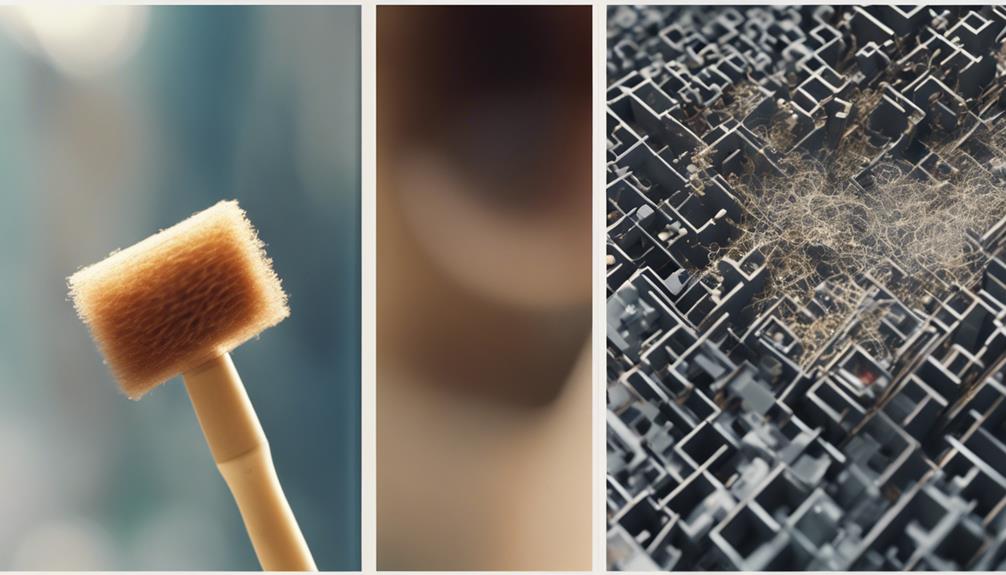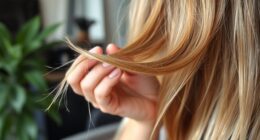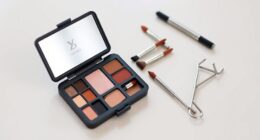To repair heat-damaged hair, start by understanding the damage: heat strips away your hair's natural barrier, compromising its internal structure and leading to dryness, brittleness, and breakage. Prevent damage by using heat protectants, keeping tools at or below 365°F, and limiting heat styling. Repair broken bonds with products containing reparative peptides and amino acids, like Olaplex No. 3 Hair Perfector and SheaMoisture Coconut Oil. Next, focus on nourishing and rebuilding your hair's internal structure. By following these expert tips and incorporating the right products into your routine, you'll be well on your way to revitalizing your hair – and that's just the beginning.
Key Takeaways
• Use heat protectant sprays or serums before styling to prevent damage and breakage from high temperatures.
• Limit heat styling frequency and opt for lower heat settings to minimize damage and preserve natural moisture.
• Repair broken bonds with ingredients like bis-aminopropyl diglycol dimaleate to strengthen and rebuild the hair's internal structure.
• Nourish and hydrate damaged hair with products containing reparative peptides, amino acids, and coconut oil for rejuvenation.
• Regular trims and maintenance with Olaplex No. 3 Hair Perfector and similar products can restore hair's vitality and strength.
Understanding Heat Damage
When you regularly expose your hair to high temperatures, you're effectively stripping away its natural protective barrier, leaving it vulnerable to damage. This heat damage occurs when the f-layer and cortex are compromised, resulting in dry, rough hair.
The excessive heat exposure breaks protein bonds, primarily keratin, compromising hair structure and leading to dryness and breakage. Continual heat exposure causes persistent dryness, loss of essentiality, and diminishes hair's shine and health.
To repair heat-damaged hair, you need to understand the extent of the damage. The cortex, the innermost layer of your hair, is where the damage occurs. When heat strips away the natural protective barrier, the cortex becomes vulnerable to damage.
Restoring heat-damaged hair involves using treatments with reparative peptides and amino acids to repair the damaged cortex. Reducing heat usage and considering a haircut to prevent further breakage are also essential steps in the repair process.
Causes of Heat Damage
As you explore the causes of heat damage, you'll discover that thermal styling tools, excessive heat exposure, and lack of protection are the main culprits.
When you use flat irons, curling wands, and other heat styling tools frequently, you're putting your hair at risk of damage. Additionally, not using heat protectants and subjecting your hair to excessive heat can lead to weakened hair structures and, ultimately, heat damage.
Thermal Styling Tools
Thermal styling tools, like flat irons, curling irons, and blow dryers, can be your hair's worst enemy, reaching scorching temperatures up to 450°F that can cause irreparable damage.
When you use these tools without proper protection, you're exposing your hair to extreme heat that can strip away its natural moisture and protective layers, leading to dryness and damage.
Prolonged or frequent use of thermal styling tools can weaken your hair's structure, resulting in breakage and split ends. The high heat can also alter the protein bonds in your hair, making it more prone to brittleness and dullness.
To minimize heat damage, it's essential to use a heat protectant spray before styling with thermal tools. This creates a barrier between your hair and the high temperatures, reducing the risk of heat damage on hair.
Excessive Heat Exposure
Excessive heat exposure from styling tools can lead to catastrophic damage, stripping your hair of its protective layers and leaving it vulnerable to dryness and damage.
When you subject your hair to high temperatures, the protein bonds that hold it together start to break down, compromising its structure. This can result in heat-damaged hair that's prone to dryness, breakage, and loss of vitality.
Without proper protection, frequent heat styling can lead to persistent damage, making it essential to take preventative measures.
Using a heat protectant before styling can help shield your hair from the intense heat, but it's equally important to reduce the frequency of heat styling to minimize damage.
Lack of Protection
When you forego heat protection products, you're leaving your hair vulnerable to the mercy of high temperatures, which can wreak havoc on your locks. Without a protective barrier, your hair is exposed to direct heat, causing the cuticle to weaken and moisture to evaporate, leading to dryness and damage.
This lack of protection can result in heat damage, which occurs when your hair is repeatedly exposed to high temperatures without any protective measures. As a consequence, your hair's structure weakens, leading to brittle, rough, and lackluster locks. Additionally, failure to shield your hair from heat styling tools can lead to protein bond breakage, further compromising your hair's integrity.
Using heat protection products is essential to prevent heat damage and maintain the health of your hair, especially when using hot styling tools. By skipping this important step, you're putting your hair at risk of damage, breakage, and a host of other issues.
Signs of Heat Damage

You can identify heat damage by looking out for a combination of symptoms, including dryness, brittleness, and split ends, which can leave your hair looking dull and lackluster. As you examine your hair, you may notice that it's prone to frizz, has a rough texture, and has lost its natural pattern. The cuticle may appear damaged, leading to moisture loss and weakened hair strands.
Here are some common signs of heat damage to look out for:
- Dryness and brittleness: Heat-damaged hair often feels dry and brittle, lacking its natural shine and elasticity.
- Split ends and breakage: When heat damage occurs, the hair's protein bonds are altered, leading to weakened strands that are prone to breakage.
- Faded color and lack of shine: Heat damage can cause color-treated hair to fade faster, and the hair's natural shine to dull.
Recognizing these signs of heat damage early is important to prevent further deterioration of hair health. By understanding the signs of heat damage, you can take the necessary steps to repair damaged hair and restore its natural beauty.
Preventing Heat Damage
To prevent further damage and restore your hair's natural beauty, it's important to take proactive steps to safeguard your locks from heat styling tools. Using a heat protectant before styling is essential, as it creates a barrier between your hair and high temperatures.
Additionally, keep your heat styling tools at or below 365 degrees Fahrenheit to prevent irreversible damage. When blow-drying, opt for a lower setting and maintain a distance from your hair to minimize heat exposure.
It's also essential to limit the frequency of heat styling to reduce the risk of heat damage. Investing in quality heat protectant products is crucial to safeguard your hair from the harmful effects of heat styling.
Repairing Heat Damage

Heat damage can leave your hair fragile, brittle, and prone to breakage, but there are ways to repair and restore your locks to their former glory. High temperatures can permanently alter keratin proteins in the hair, leading to dryness, split ends, texture changes, and potential hair loss.
However, with the right treatments, you can repair heat-damaged hair without cutting it.
Here are three essential steps to repair heat-damaged hair:
- Remove damaged ends: Regular trims are essential to remove damaged ends and prevent further breakage.
- Hydrate and nourish: Use products that can help repair broken bonds, such as Bis-aminopropyl diglycol dimaleate, and deep conditioning masks to improve the appearance of heat-damaged hair.
- Use products for repairing heat-damaged hair: Look for products like Olaplex No. 3 Hair Perfector and SheaMoisture 100% Extra Virgin Coconut Oil that can help repair and restore your hair.
Product Recommendations
When repairing heat-damaged hair, incorporating the right products into your routine can make all the difference between brittle locks and silky strands. To start, you'll want to focus on nourishing and moisturizing your hair with a product like SheaMoisture 100% Extra Virgin Coconut Oil. This will help lock in moisture and provide much-needed hydration to dry, damaged hair.
Next, consider using a product that can repair and strengthen hair bonds, such as Olaplex No. 3 Hair Perfector. This will help restore your hair's natural strength and elasticity.
To prevent future heat damage, use a heat protectant like OUAI Heat Protection Spray or Olaplex No. 7 Bonding Oil before styling with heat tools. These products will create a barrier between your hair and the heat, preventing damage and breakage.
Bond-Building and Repair

By using bond-building treatments, you can repair the broken disulfide bonds in your heat-damaged hair, restoring its internal structure and improving its resilience. These treatments work to strengthen and rebuild the hair's internal structure, making it less prone to breakage.
Here are some key benefits of bond-building treatments for heat-damaged hair:
- Repair broken bonds: Bond-building treatments like Olaplex No. 3 Hair Perfector contain ingredients like bis-aminopropyl diglycol dimaleate that help restore damaged hair bonds.
- Strengthen and rebuild: These treatments work to strengthen and rebuild the hair's internal structure, making it more resilient to heat styling and other forms of damage.
- Prevent further breakage: Regular use of bond-building products can notably improve the health and appearance of heat-damaged hair, preventing further breakage and damage.
Styling With Heat Safely
When styling your hair with heat, it's important to take the right precautions to prevent further damage.
To do so, you'll need to choose the right tools, prep your hair before styling, and set the temperature wisely – all of which are essential steps in minimizing heat damage.
Choose the Right Tools
To style your hair safely with heat, you need the right tools for the job, and that means selecting heat styling tools that cater to your hair type and minimize damage. The right tools can make all the difference in preventing heat damage.
Here are some key features to look for in heat styling tools:
- Adjustable temperature settings: This guarantees you can style your hair at a safe temperature that suits your hair type.
- Ceramic or tourmaline plates: These materials distribute heat evenly and minimize damage to your hair.
- Built-in heat protectant features: Some tools come with built-in heat protectant features, providing an additional layer of defense for your hair.
Remember to always use a heat protectant spray or serum before using any heat styling tool to shield your hair from damage.
With the right tools and precautions, you can style your hair safely and minimize heat damage.
Prep Hair Before Styling
Before you start styling with heat, make sure to prep your hair by washing and drying it thoroughly to prevent any additional damage. This step is essential in maintaining the health of your hair.
Next, apply a heat protectant spray or serum to create a barrier between your hair and the heat, reducing the risk of damage.
When sectioning your hair, work in small sections to guarantee even distribution and minimize exposure time. This will help prevent hot spots that can cause damage.
Use the appropriate heat setting on your styling tools based on your hair type to avoid excessive heat exposure. For instance, if you have fine hair, use a lower heat setting to prevent damage.
Set Temperature Wisely
You set the temperature of your styling tools wisely by keeping them below 365 degrees, an essential step in preventing irreversible heat damage. High heat styling can lead to dry, brittle hair with increased breakage, so it's important to be mindful of the temperature.
Here are three key reasons to keep your styling tools at a lower temperature:
- Protect hair's moisture:
Lower temperatures help preserve hair's natural moisture, preventing dryness and brittleness.
- Preserve protein structure:
Using lower heat settings safeguards hair's protein structure, reducing the risk of damage and breakage.
- Reduce damage risk:
Lower temperatures minimize the risk of long-term damage, allowing you to style your hair safely and maintain its health.
Maintaining Healthy Hair

Healthy hair thrives on a delicate balance of moisture, where every strand is nourished and protected from the inside out.
To maintain healthy hair, you need to find the perfect balance between moisture and protein.
When your hair is exposed to heat, the protein bonds can break, leading to dryness and breakage. To prevent this, it's crucial to protect your hair from thermal damage by using heat protectants and reducing heat styling tools' temperature and drying time.
Regular trims can also help prevent split ends and maintain overall hair health.
Additionally, using products with reparative peptides and amino acids can help rejuvenate heat-damaged hair.
By following these tips, you can restore your hair's natural vitality and strength.
Frequently Asked Questions
How to Fix Extremely Heat Damaged Hair?
To fix extremely heat damaged hair, you'll need to take drastic measures. Start by cutting off the most damaged parts to prevent further breakage and promote healthy growth. Once the damaged ends are removed, focus on deep conditioning and using protein treatments to strengthen the remaining hair. Look for products that contain ingredients like keratin, argan oil, and coconut oil, as these are considered top remedies for hair damage. Additionally, be gentle with your hair, avoid heat styling, and consider protective hairstyles to give your hair the chance to recover.
Next, incorporate deep conditioning treatments and protein masks to restore moisture and strength. Regular trims are essential to remove split ends and prevent further damage.
With patience and consistent care, you'll start to see noticeable improvements in hair health.
What Is the Best Product for Heat Damaged Hair?
You're looking for the best product to repair heat-damaged hair. Olaplex No. 3 Hair Perfector is a top contender, thanks to its bond-repairing capabilities.
Alternatively, you might consider SheaMoisture 100% Extra Virgin Coconut Oil for nourishing and restoring moisture.
If you're dealing with weak hair bonds, Acidic Bonding Concentrate Intensive Treatment could be the way to go.
For reparative properties, Silk Bloom Strengthening Hair Mask is a great option.
How to Repair Scorched Hair?
You're likely among the 60% of women who've experienced heat damage, leading to scorched hair. To repair it, start by understanding that excessive heat exposure damages the hair cuticle and cortex, causing dryness, frizz, breakage, and loss of elasticity.
Treat your hair with deep conditioning treatments, protein-rich products, and regular trims to restore its health.
How Long Does It Take Hair to Recover From Heat Damage?
You're wondering how long it takes for your hair to recover from heat damage. The answer depends on the extent of the damage and your hair type.
If the damage is minor, you'll start to see improvements in a few weeks with proper care. However, severe damage can take several months to a year or more to fully recover.
With consistent use of reparative products and treatments, you can expedite the process.
Conclusion
With your newly acquired arsenal of heat damage repair strategies, you're now equipped to tame the frizzy beast that's taken over your locks.
Like a phoenix rising from the ashes, your hair can be reborn, stronger and more resilient than before.
By incorporating bond-building treatments, shielding your strands from heat, and styling with care, you'll be well on your way to restoring your hair's former glory.
The journey to healthy, vibrant hair begins – and ends – with you.









